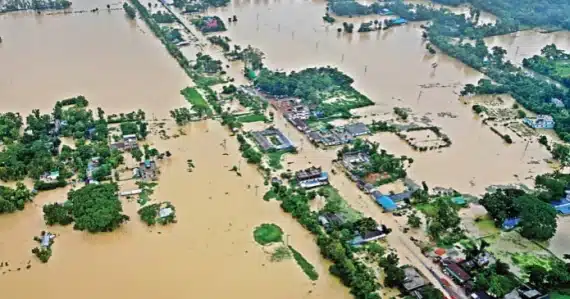In the remote riverine belts of northern Bangladesh, the once life-giving Teesta River has turned merciless, swallowing homes, farmland, and hope — leaving entire communities on the verge of collapse.
Over the past few weeks, as the river’s water level fluctuated, erosion has intensified dramatically. It has stripped away the last fragments of security from countless farming families in Rangpur, Kurigram, Lalmonirhat, Gaibandha, and Nilphamari.
Arable land has vanished, homesteads have crumbled into the swirling current, and with them, generations of memories and livelihoods have been swept away.
According to the Rangpur Divisional Office of the Water Development Board (WDB), 59 houses in these five districts have been devoured by the river in just the past seven days.
More than 100 others stand precariously at the edge, with residents warned to evacuate before the inevitable strikes.
Officials report that erosion is currently active at 38 points along the Teesta. While emergency protection work is underway, for many, the response has come too late.
On a crumbling riverbank in Kutirpara village, 65-year-old farmer Akbar Ali sat in silence, watching the soil slide into the river. His voice cracked as he told the UNB correspondent, “This land is all I have left from my father. The water is falling, but the erosion is rising.”
In Balapara village, elderly farmer Monsur Ali could barely speak of his loss. “The Teesta has swallowed my homestead. I’ve lost everything — my land, my home. I am left with nothing.”
Nearby, 45-year-old Alema Khatun wept openly. “Save us, our lives are finished. The river has taken everything. Where will we go? What will we eat? The river will take the rest soon.”
For Tasor Uddin, whose previous home now lies beneath the riverbed, the nightmare continues. “The erosion has reached right beside my current house. It may fall into the river any moment. The government officials just come and give us words,” he said sadly.
Another villager, Abul Hossain, echoed the frustration of many. “We don’t want relief; we just want protection. If sandbags had been placed along the bank earlier, the river wouldn’t have taken our land.”
The pain is equally raw for Mensur Ali, 56, of Tepamdhoopur in Kaunia upazila. Years ago, he bought 25 decimals of land to build his home. Now, 20 decimals are gone. “Only five decimals remain, and even that is at risk of being washed away tonight. If the river takes my homestead, I’ll have nothing left.”
Tepamdhoopur Union Parishad Chairman Rashedul Islam painted a grim picture: “Villages like Rajib, Haricharan Sharma, Hoybatkha, and Bishwanath are being eaten alive by the river. We sought 4,000–5,000 geo-bags for protection but received only 250 — far short of the need.”
In Nilphamari’s Dimla upazila, six of ten unions are flood-prone, with erosion striking even in the absence of major flooding. Villages like Purbo Duholpara and Purbo Baishpukur now teeter on the brink. Residents say that without swift action, they will be left destitute.
Ahsan Habib, Superintendent Engineer of the WDB Rangpur zone, said erosion is severe across the region. “We are carrying out protection work in some areas and have sought more allocations. Once we receive them, geo-bag dumping will begin.”
Rangpur Divisional Commissioner Shahidul Islam said local administrations have been instructed to visit affected areas and take urgent measures. The WDB has been ordered to intensify work to curb the destruction.
But for the thousands standing on collapsing embankments, watching their land crumble inch by inch, hope is fading fast.
“To them, the Teesta’s slow, steady bite feels less like nature’s course and more like a death sentence,” said Chairman Rashedul Islam.


